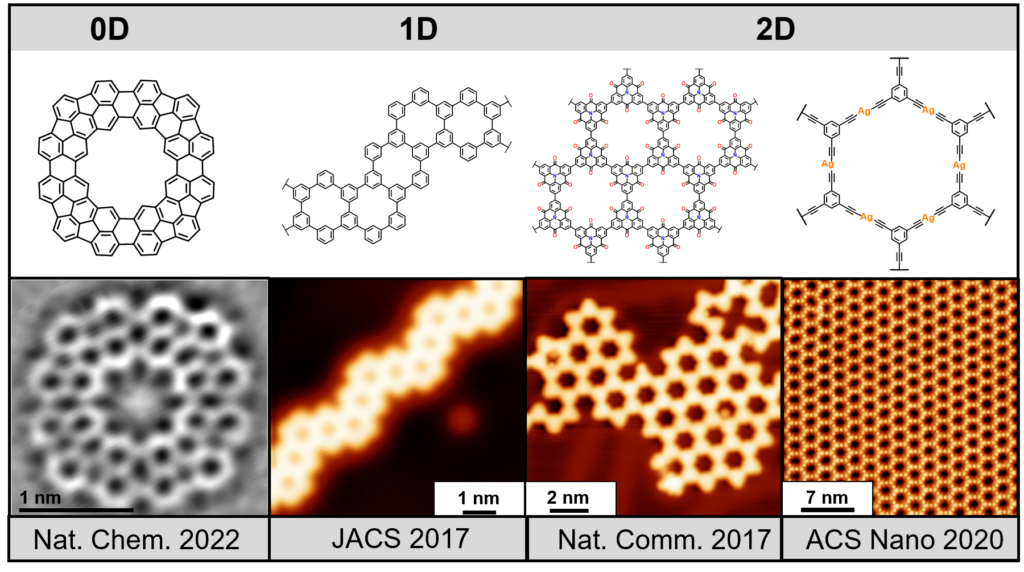On-surface synthesis of atomically-precise molecular nanomaterials
The growth of long-range ordered two-dimensional (2D) porous graphenes in ultra-high vacuum (UHV) is still a major challenge. The bond flexibility in the molecular building blocks and the irreversibility of the newly formed C-C bond prohibit an error correction during the network formation. Therefore, electronic properties of bottom-up fabricated 2D networks remain experimentally widely unexplored, despite the exciting physical properties such as a half-metallic character or Dirac cones predicted by density-functional theory (DFT). In line with graphene nanoribbons, porous graphene exhibits a band gap that can be controlled by pore size, density, functionalization, and geometry.
Our research explores different coupling reactions and develops strategies to synthesize novel one-dimensional and two-dimensional carbon-based molecular materials on metal and insulating surfaces. We can identify their structure at the atomic scale by using high-resolution scanning probe microscopy at low temperatures (STM/ncAFM at 4K). In addition, we study the local electronic properties of the created one-dimensional and two-dimensional nanostructure using scanning tunneling spectroscopy (STS). Exciting aspects are how the band structure in two-dimensional covalently-linked networks can be tuned by using functional groups and changing the geometry of the networks (Dirac cone engineering). We aim to develop new carbon allotropes in a bottom-up approach, including graphyne-like materials which involve both sp2- and sp-carbon atoms and have many interesting properties, e.g. the potential of direction-dependent Dirac cones.
Our research activities in the field of on-surface synthesis are part of the SFB 953 Synthetic carbon allotropes and RTG 2861 PCL Planar carbon lattices.

Selected publications:
- Planar π-extended cycloparaphenylenes featuring all-armchair edge topology
F. Xiang, S. Maisel, S. Beniwal, V. Akhmetov, C. Ruppenstein, M. Devarajulu, A. Dörr, O. Papaianina, A. Görling, K.Y. Asharov, S. Maier
Nat. Chem. 14, 871–876 (2022) - Metalated Graphyne-Based Networks as 2D Materials: Crystallization, Topological Defects, Delocalized Electronic States and Site-Specific Doping
Z. Yang, T. Sander, J. Gebhardt, T.A. Schaub, J. Schönamsgruber, H. Soni, A. Görling, M. Kivala, S. Maier
ACS Nano, 14, 12, 16887-16896 (2020) - Two-dimensional delocalized states in organometallic bis-acetylide networks on Ag(111)
Z. Yang, J. Gebhardt, T.A. Schaub, T. Sander, J. Schönamsgruber, H. Soni, A. Görling, M. Kivala, S. Maier
Nanoscale, 10, 3769-3776 (2018) - Hierarchical on-surface synthesis and electronic structure of carbonyl-functionalized one- and two-dimensional covalent nanoarchitectures
C. Steiner, J. Gebhardt, M. Ammon, Z. Yang, A. Heidenreich, N. Hammer, A. Görling, M. Kivala, S. Maier
Nature Communications, 8, 14765 (2017) - On-surface synthesis of porous carbon nanoribbons from polymer chains
M. Ammon, T. Sander, S. Maier
J. Am. Chem. Soc., 139 (37), 12976–12984 (2017)